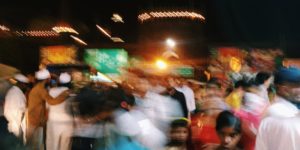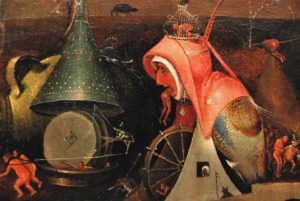The first sounds of the morning are of tuk-tuk and taxi engines as they come to life, their honking horns alongside the footsteps of the city’s informal working class taking to the streets. And, even earlier than that, the song and chant of Hindu morning prayer, and the feral dogs that slink to the shadows to sleep, no longer dominant as the sun begins its climb from behind Agra, India’s low hills.
It is near the end of February, in the year 2020, we are in Agra, my sister and I, in Uttar Pardesh, a state in the north of India, standing at the Taj Mahal before sunrise; standing before the majesty of its soaring dome, those great minarets, and the carved walls of ivory-white marble. It is 6:53 in the morning, 7 minutes left until sunrise, we’ve made it just in time.
A scene: A young Dutch couple with blonde hair wearing sandals, they appear to be on their honeymoon, pause mid-kiss before the calligraphy of Persian poems and semi-precious stones, taking pictures against the backdrop of plant motifs and Arab Ayaat. As a tour guide leads a bustling group of Germans squinting past the mosque – they remove their shoes as one big group to go inside. A low fog blocks the sunlight as an elderly Japanese man stares down at the map in his hands. Hundreds have entered already, and hundreds more are waiting still to get in. We haven’t eaten breakfast yet.
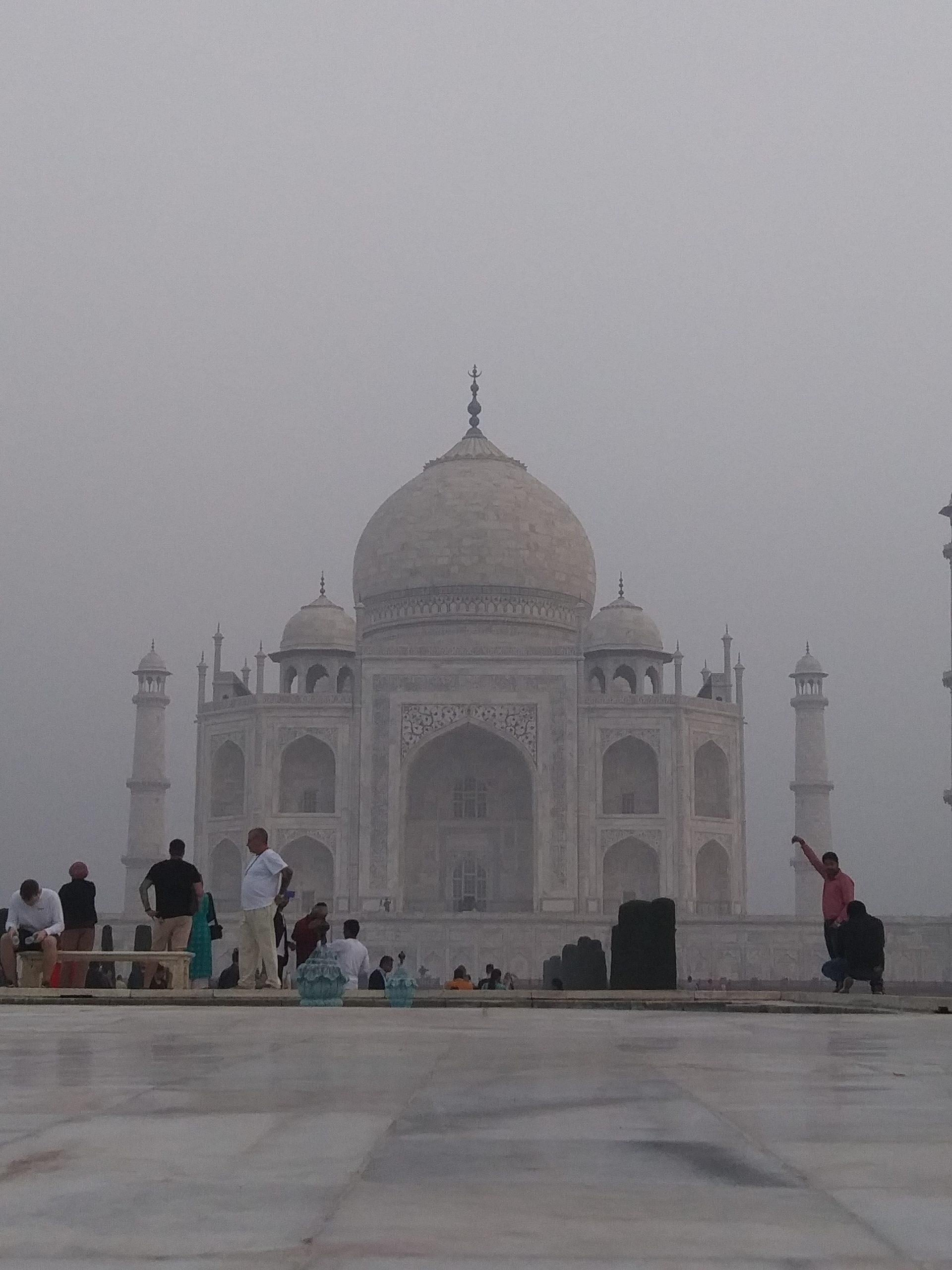
Could a story about India begin without first introducing its rich history and culture, the traditions maintained over centuries, and these preserved monuments of old? This Taj Mahal, perhaps the best-known of the country’s landmarks; this tomb built by Mughal emperor Shah Jahan for his wife Mumtaz Muhal and came to be the place of their eternal rest, stands tall above a modern world constantly in-flux; these global attractions and world-class landmarks make a country much easier to identify. It is fitting, then, that this is the place where we have begun our trip in earnest.
But as with any place we have not been introduced to before, we know it only through abstracts – through the films, the music, and stories about it; the lessons in geography class; historic and current events. But too do we understand it only, when it is not our own (not our realm through which we might identify ourselves), as the greater world understands it?
No.
As viewed from the perspective of those who live here, as described by our driver, there is a strong pride in India, and subsequent need to show the country to a world that generally only knows it through these abstracts – through Bollywood and Gandhi and yoga; through a caste system that creates the highest of economic highs and lowest of economic lows – and also a certain apprehension that the land will, once again, be misrepresented by tourists. That those pictures of poverty, of overpopulation and dust set alongside those of opulent luxury and historic monument, will be left in their simple duality without any attempt to understand everything that lies between.
After. A languid cat with matted fur perches on the gutter of Joney’s Place in the sun (where we eat our morning meal), its metronomic tail swinging along the plastered brick wall. The call of street vendors selling local and handmade wares along the road. Those early-morning drivers now standing in front of us, behind us, at our elbows offering fares at rates always lower than the last, and, they promise you, the next or anywhere else you’ll find. 100 rupees! 50 rupees! 20…
The din of the city grows as each minute passes morning to day to night – those initial sounds of sunrise remain, and every new sound is added one atop of another until its variegated chorus bounces from every corner, every street, every window, every wall, and there is no escape into silence.
This is not my country. Not where I was born, where I work, or where I lay my head. And I cannot, should not, will not speak for its people. To share my experiences, what I was shown, taught, and told comes with a responsibility not only to do so in complete honesty, but also to do so without filtering through a lens developed primarily, functionally in the West.
I try.
The Wedding (In New Delhi)
Our trip looks like this: We fly into the Delhi airport, sleep for a few hours at the hotel, then leave mid-morning for Agra. There we spend one night in a hostel along the garden, and visit the Taj Mahal in the morning, at sunrise. We spend the afternoon in the city, and from there we leave for Jaipur, the Pink City, for three days, and then travel back to Delhi for the wedding of an old college friend and the former roommate of my sister. The flight to Delhi is 14 hours from Vancouver. We take the train through the countryside, from one city to the next.
The colors of the Chandni Chowk market might help illustrate the flash that comes from those first moments. Or the handmade goods spilling from shelves. Selling, changing hands. Or the Khari Baoli spice market, the endless colors and smells that serve both as “must-see” destinations for visitors and a functional role in daily life.
As a visitor, there is constant push by locals to visit these marketplaces; and the cottage industry subsidized by the government, from which local precious stones, handwoven carpets, clothing, paintings and portraits by the artisans of the country spread out into the world, keeping a tradition in danger of disappearing alive as the economy continues to modernize.
But in this pocket of Delhi, far removed from the working-class neighborhoods of the city, it’s easy to forget not everyone lives stable lives – and realize how true it is that proximity is a natural shortcut to empathy.
But if there is haze to the cityscape, there is also a brilliant red sun – the dark outline of the Gate of India, and the Rashtrapati Bhavan against the horizon. It is the bustle of the city, that frisson of human bodies, cars and motorbikes, dogs sleeping in the sun across the horizontal brutalism of the city center. It is the influence of British architecture and design still clinging to street corners (side-by-side with the organic nature of Indian day-to-day life), the persistent, informal economy that offers anyone with a few rupees just about anything they could ever hope for. In this, we find the changing tides, and a country finding a voice.
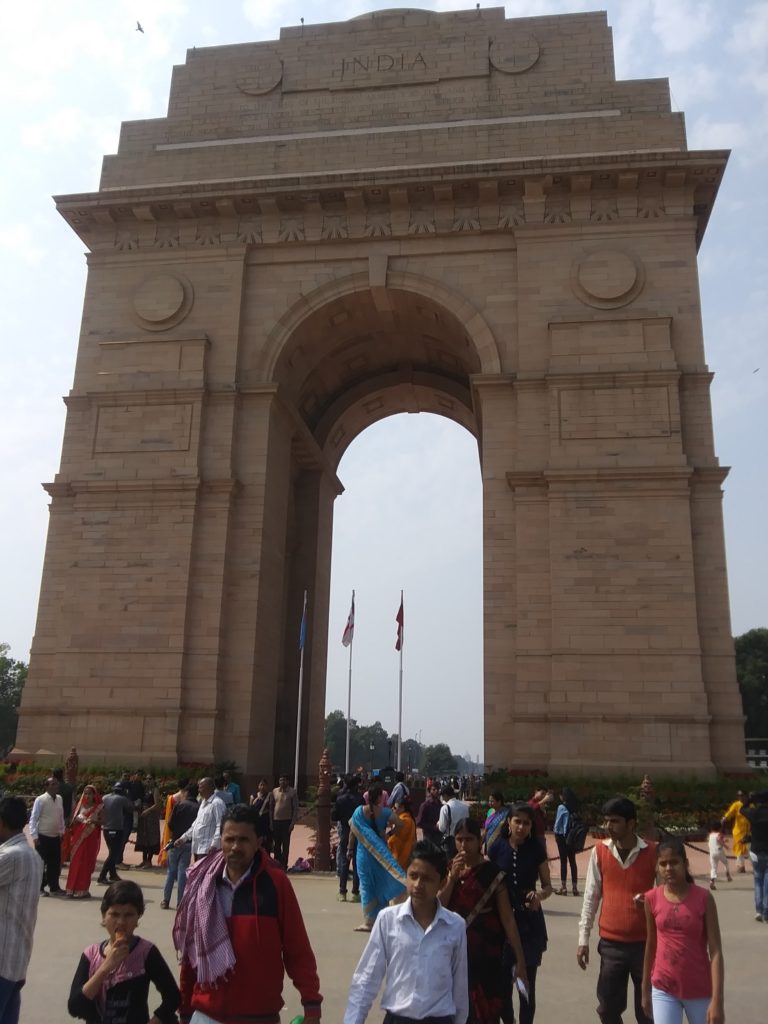
We are staying at the Ambassador Hotel – we wake in New Delhi to the sound of traffic, this eternal honking of horns, and construction in the distance. There’s a market not far away and the hum of conversation can be heard as well – it is the sound and movement of people that underlies it all. As monkeys hop along the walls of government compounds and campuses.
The wedding is the reason we are here – the primary impetus for the trip – and where we will be spending the largest portion of our time.
And never has a celebration been so warm and welcoming – never a sea of unfamiliar faces so laced with joy and a willingness, or no, more of a necessity to share it with others, with guests of the wedding. It is not conversation of selfishness, there is no need for ego or accomplishment-based inducement: These doors are open, food and drink and company offered with a smile even though we are strangers to most.
How easy it is to leave the world behind. Focus on the party. The Baraat – the bridegroom’s wedding procession in which we accompany him to the ceremony while drinking and dancing to drums and music, and the feelings of general cheer and excitement on the way to the ceremony.
Here I meet her. She is strikingly beautiful – call her Kareena, as the actress Kareena Kapoor. Or Samaira, as she should be called. Though the pain of her back, an injury the result of an auto accident, kept her from dancing when I asked.
And she perhaps best captures the dichotomy of this country in flux. It is impossible to avoid discussion on the topics – those issues not so unlike the United States’ nationalism and tribalism; the relationship between PM Modi and President Trump – as she says, “One idiot recognizes another” – but there is a humanism, not a cynicism, that defines her words: If she is frustrated, exasperated, and angry it because people are suffering, dying as a result of outmoded views of religion and race. And the inability to address it fully as a country.
And so her questions persist, “What do you think of India? Of Delhi?
“What has surprised you?
“One thing you have loved about the country? And one thing you do not?
With an underlying commitment to proving that it is, in a word, normal; a normal society living life just as we do in the west. When I see her for the last time, it is at a coffeeshop at the Khan Market, where we sup coffee surrounded by pastel walls and furniture and buttercream pastries.
See – she says – we aren’t so different after all.
And the rest: The handsome fashionista in his embroidered dupion silk and his beautiful wife who command every room they enter in their custom-made outfits. The witty intellectual who had lived in Philadelphia long enough to mimic Rocky’s run to the top of the steps. The restaurant owner dedicated to the modernization of Indian cuisine – a blend of old word and new. And the bride and groom, the most gracious of hosts, thinking first of their upbringing and tradition and second of what they’ve learned in the growing number of years since. There is nothing more to be said here. Only that a wonderful time was had, in a wonderful place with wonderful people, drunken, stimulating, dynamic, beautiful, remembered fondly, and never to be forgotten.
The Politics of Place
But another side: The buildings in New Delhi are low. The city is defined by neighborhoods – or defined perhaps the stark differences between the city’s neighborhoods. A city of some 25 million people. But too is it cohesive – the monuments and government mall, the “ceremonial axis” of New Delhi, lined with those grand buildings of authority – recalls as much grandeur as those of ancient Rome. But this is not a city living in the past, even as the past crawls forward from beneath trees and cracks in walls – no. There is future here, halting, perhaps, as the violence (some, many have called them pogroms) against Muslim communities, and a rising middle class; a growing economy, and rising wealth and industry in the country’s capital.
Pollution too is a result of this. We cannot ignore the trash-strewn banks alongside the railroad tracks and rivers, picked over by the aforementioned dogs, as well as cows, and monkeys and boars and pigs that live amongst their human counterparts.
And that our trip overlaps with that of U.S. president Donald Trump – we arrive in Agra the same day as him; are in New Delhi as he delivers his speech – cannot be ignored either. Streets blocked around the train station in Agra. Crowds gather to catch a glimpse. His image is unavoidable.
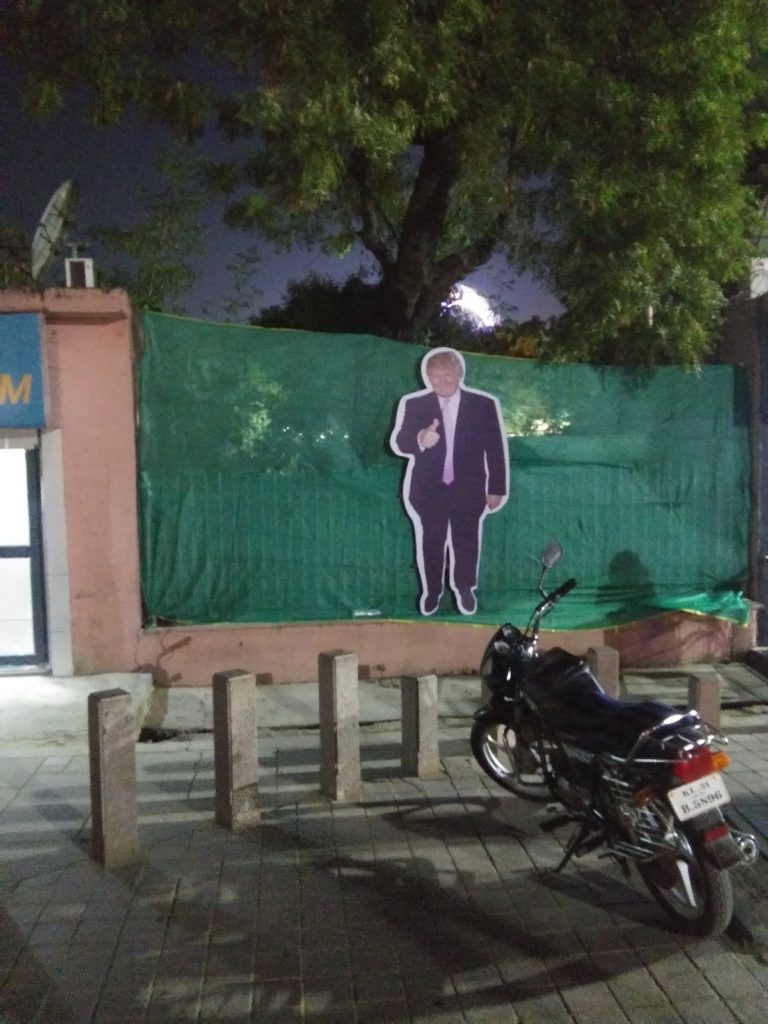
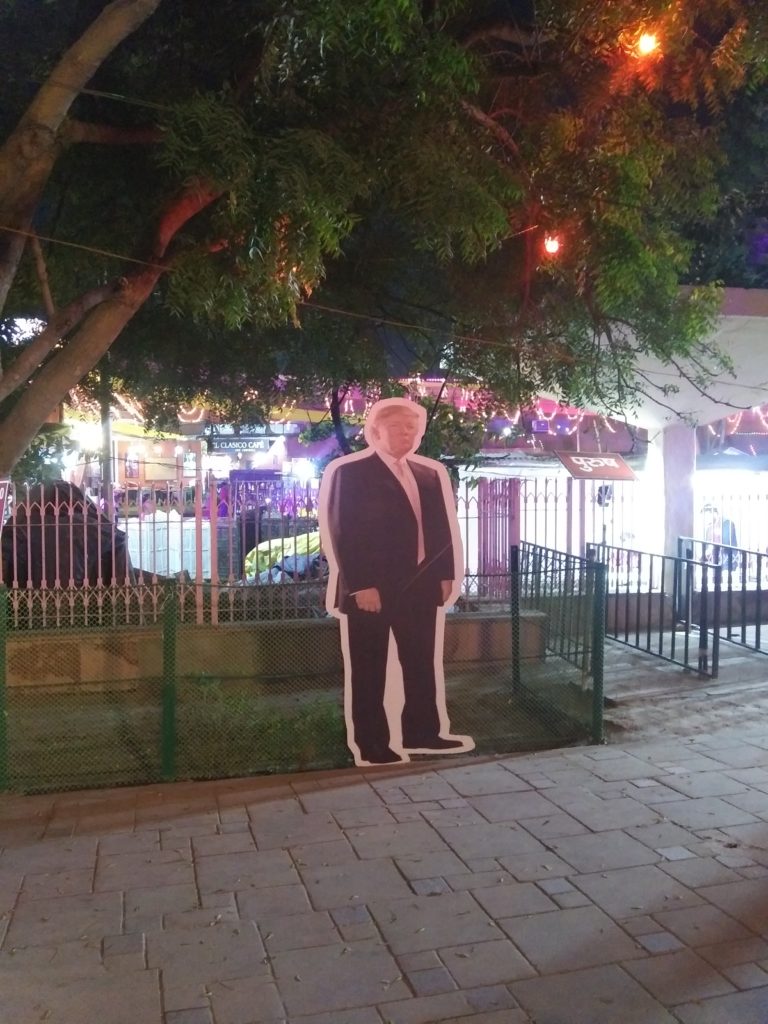
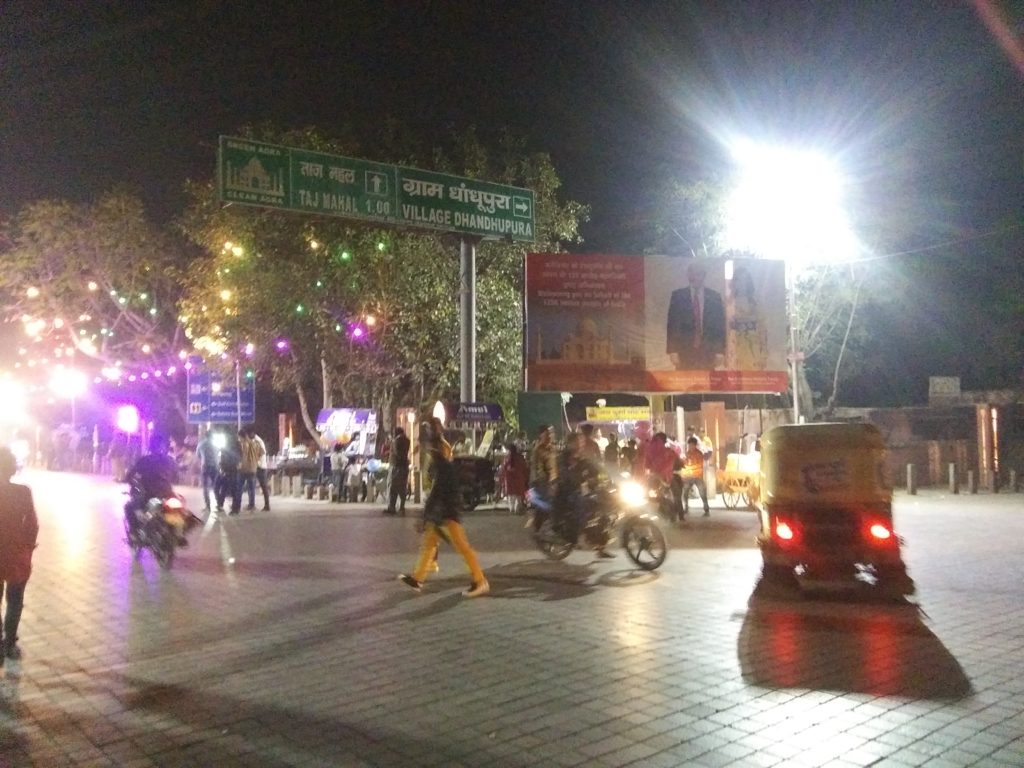
Trump’s speech in Ahmedabad, to address the comparatively minor threat of “Islamic terrorism” – which coincides with the violence against Muslim communities in Delhi, something he was, unsurprisingly, silent about throughout his trip – sounds not unlike the fear-mongering and anti-Islamic sentiment that has defined much of his tenure in the United States, and certainly helps illustrate his warm relationship with India’s PM Modi.
Briefly: Prime Minister Modi has drawn criticism for his anti-Muslim rhetoric, and has been accused of trying to create a Hindu nationalist state. Much of the rioting comes as a response to the government’s Citizenship Amendment Act (CAA), which was passed in December 2019 and creates a path to Indian citizenship for undocumented immigrants of Hindu, Sikh, Buddhist, Christian, Jain and Parsi backgrounds… though not Muslim. There were protests against the CAA, and the recent spate of violence is considered to be a nationalistic response to those protests, exacerbating tensions have existed for decades, bringing what had been a simmer once again to a boil.
For more information, read this: Trump’s India trip ignored the New Delhi riots. But his silence isn’t the most damning
One guest at the wedding reception, a shop owner, describes the absence of her Muslim employees, telling us that it is too dangerous for them to leave their homes, even to get to work. The pervading notion is that “…if you leave in the morning, you might not come back that night.” They stay home with their children, missing out on the day’s pay.
But to say that our trip has been defined by the violence in Delhi is both an under- and an over- statement – we are far from the violence at the Ambassador, and it is the same on television screens in our hotel as it would be had we been sitting on our couch at home, even if the proximity is much closer. And yet it is the topic of conversation for so many, unavoidable, and to know that it is only a matter of kilometers between us and the anti-Islamic violence that takes 50 lives, countless more left injured on the street, and three mosques burned by the time of our departure, hangs heavy still, and overshadows the otherwise joyous occasion.
And our takeaway from this brief visit has as much to do with the xenophobic rhetoric as it does the absurdity of governmental ceremony; the pomp and circumstance in the face of these attacks. For example: In order to keep the many monkeys in the area away from Mr. Trump, five larger monkeys were brought in to scare them off. For example: Mr. Trump’s security detail said that the president will not be visiting the sacred crypt of the Taj Mahal, as the doorway is only 5 feet tall, and the president will not bow his head to step inside.
And, perhaps the most-inane gesture of all, that a hastily wall will be built in Gujarat to block the nearby slums from his view.
But perhaps this is more the point: That it is not only a matter of kilometers, but mindset and point of view as well – which is nothing to say of the status and economical differences and a caste system that remains fully intact.
As described by the groom: The average middle-class person might have 2 servants. Someone who is wealthy around 9, and, as they grow older, this number could rise to 15. Two drivers (his and hers), a cook, a maid, etc. And the most-elite members of society might have as many as 30 people under their employ for their household alone, as they also add personal accountants and other managerial types to protect and maintain a lavish lifestyle.
And – as he tells us – it is common for those of the highest class to embrace their higher status: “There are those who really throw their weight around, who think they’re superior because they have money and act like it.”
Though, if this is true – no different than the United States in the exaltation of wealth – we find none of it here.
As this is not unique to India alone: It is consistent with the disparities of our modern world in general; the feeling, all across the globe, that comes from great wealth when thrown into relief against the extreme poverty (of 2/3 of people), as the (semi) contented middle class struggles to maintain their place.
“Out of sight, out of mind” aptly describes this mentality of beauty, the Taj Mahal so close to the purlieu of the city, that we would not discuss first that this exists, one next to the other, and that we are capable of addressing it, but rather simply hide it away as though it no longer exists when we cannot see it. While proximity indeed has long been a shortcut to empathy, it goes to show how close those most-selfish of the world can be, and still remain, willfully ignorant.
We know that humanity is not defined by place, that power is not solely for those who own, have, make the most, that peace in community comes not from fighting solely for yourself, but fighting for others; by connecting, honoring the social nature that has long defined forward progress for the species as a whole. We know that slums are not made by those who live in them, but rather the other way around. Give anyone a suitable, respectable place to live – it is not, as many in the upper classes would like to believe, simply a difference of class or character, that those in the lower classes don’t realize their situation and can therefore be entirely happy in it – and they will take care of it.
The reception comes to a close – it is well past midnight and the streets are quiet now outside. Empty bottles lying aslant on the tables with half-stacked plates and used napkins. We take a car back to the hotel, through the fog of early morning, past the few stragglers still on the street, the dogs, alert, and the security waiting at our front gate. We walk, more float, up the five flights of stairs to room 406, our hotel room, with a mini-bar stocked full of Kingfisher beer, whiskey and wine, a shower, a warm bed. Here we sleep until morning.
Views from the Train
There is something to be said about the trains in India – or the trains of northern India, at least, as this is where we took them. We were primarily in the “Chair Class” in the AC Chair Car, which means we get our own seat, room for luggage above, and a surprising number of meals and snacks and chai throughout the journey.
There is a sense of camaraderie on the train – as everyone is corralled together and so the notion of getting along is emphasized. Conversations among strangers, and, at some point, the entire car breaks out into song, in unison, for a moment, descending into laughter at the end.
Though it is said one should not get off the train before their stop – even during the longer stops at stations throughout the countryside. There are places to buy drinks and snacks, and an objectively more pleasant place to relieve oneself, but the train will very quickly resume its journey and leave you behind. Indeed – this happened to one man in a gray suit: He stepped from the train to buy something to drink from the stand maybe 100 meters away, the proprietor of the stand took a bit too long with the change, and he had to run to hop onto an already-moving car, nearly left behind.
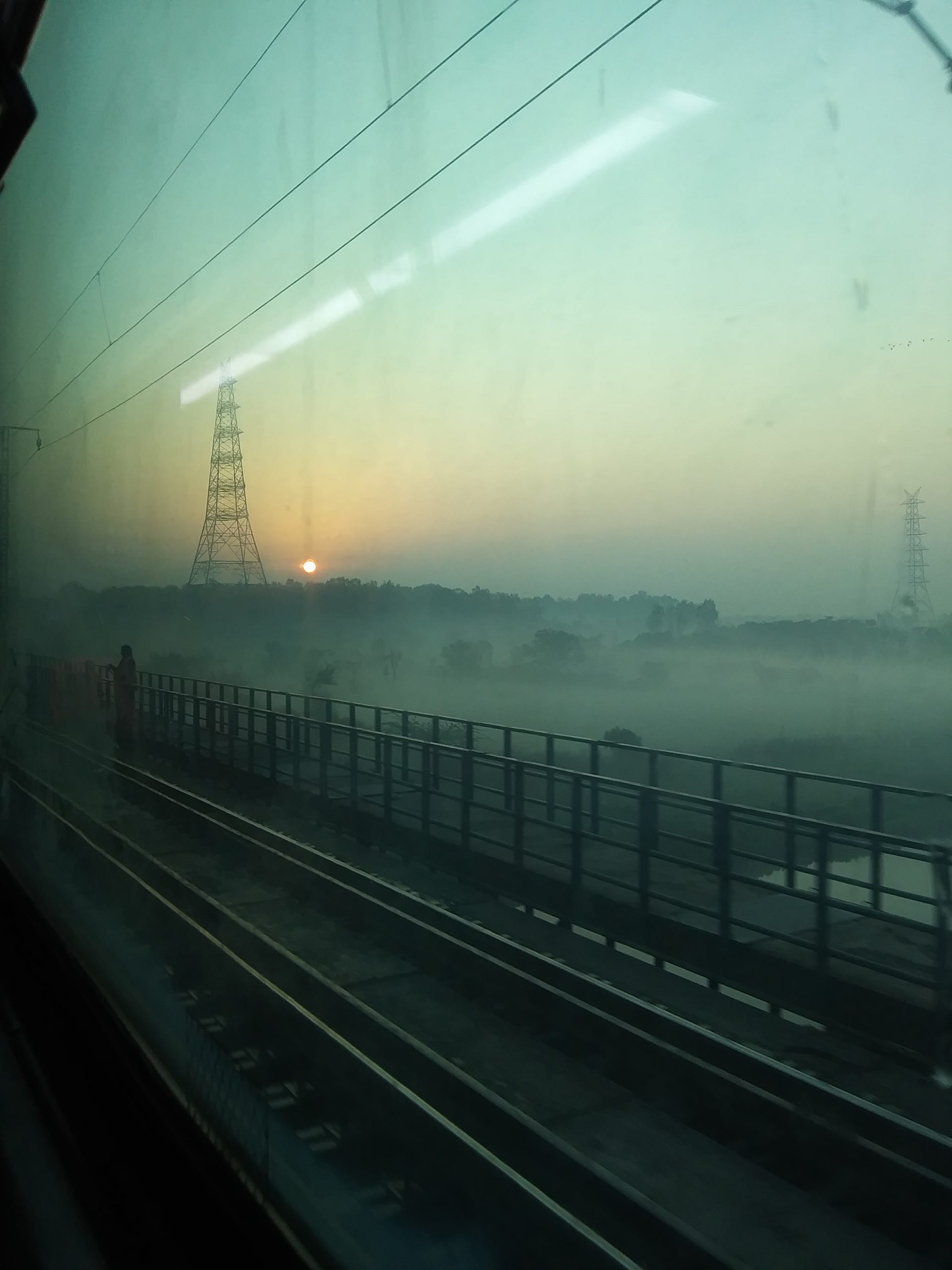
From the streets beyond the Taj Mahal – the city streets that can less be called wonders of the world and are avoided by the city’s tourists; walk the streets of Agra, beyond the tour buses and hotels meant only for tourists, and understand true destitution as you encounter it face-to-face; if this cannot be called poverty then nothing truly can – to the luxury of upper class weddings, a duality does exist. The easiest, way, perhaps, to reconcile these opposite ends of the spectrum, is to say that it is culture of extremes – the lowest of the lows on one side of the wall, and the most ostentatious lifestyle on the other.
Whether this is enough; whether this is the most honest and respectful way to describe a culture, remains unclear.
The idea that anyone could capture, or truly understand, the nature and circumstance of place in this short amount of time; that anyone could paint an accurate portrait of a country so dynamic, so colorful and full of life, history, future, is absurd. From the train, as we watch the scenery and landscape roll past – larger cities and small villages, hills, rivers, forests, sugarcane plantations and industrial centers – it offers much to ponder.
Do we tell only of, hard work, perseverance, and a noted calm; a peace among those with nothing, and romanticize the landscape thus? Try and detail a country that has so much to offer, and leaves an impact on any/all who visit?
It would be patronizing to call this a culture very much alive – this, in my lifetime at least, has never been in question. The British left officially in 1947, a much more recent piece of the country’s history, and the years since dedicated to rediscovering what was lost to colonialism and empire. And it is not for me even to ask whether or not something so vibrant, so thoroughly sincere in its commitment to that word culture, and to the sharing of that culture, could ever truly be justified by simple words on the page…
But to simply romanticize it thus would be patronizing as well – sharing these experiences with the world is something that is humanistic, yes and to try and understand a culture, a country, a tradition through a brief, however dynamic, time there could never do it justice. Through its food and music, its people, its long and proud history, the verve of its nightclubs and growing economy today. I can only try. And thus come to the realization that this, in-and-of itself is something of western privilege – to try and understand and label a country and its people, make it more palatable and explainable and story-based rather than simply letting it be. That I take the time to write is exemplary of my very different role from the people I meet. Though much has been written on the United States too, I suppose, it is with the weight of privelege behind it.
The living situations of so many, the result of makeshift housing being the only thing available; the only affordable option – poverty contributing to a housing crisis for an ever-growing population – how could we ever achieve equality under these circumstances?
Because no one is looking to eliminate the first class, but rather eliminate the second class (and third and fourth…); the notion of lower, lesser, beneath, and that our communities would not benefit from equity.
The greatest lesson here is then that there truly is no good or bad in general. Only action and result as per the situation. And this context is most important – there are no morally absolute, nor simply relative, views that could ever describe these differences, and similarities, between people raised on opposite ends of the earth. And those who would try fall immediately into fallacy.
And so I cease trying.
Against the backdrop of global pandemic – this is being written, also, in the time of COVID-19; the sort of crisis cares little for border, gender, race, income (though certainly these factors play a role in the combatting thereof) just now gaining traction and overshadowing all other discourse – it seems, suddenly, more apt to remember that this world is not nearly so large as we might think.
We leave in the morning to begin our 24-hour journey by train, then taxi, then airplane back to North America and home. With the din of the city – the now-familiar conversation of car horns, building and road construction, loud shouts and low conversation in the background, we finish the last drink of wine from the mini-fridge in the hotel, pack our bags, and say farewell for now.
